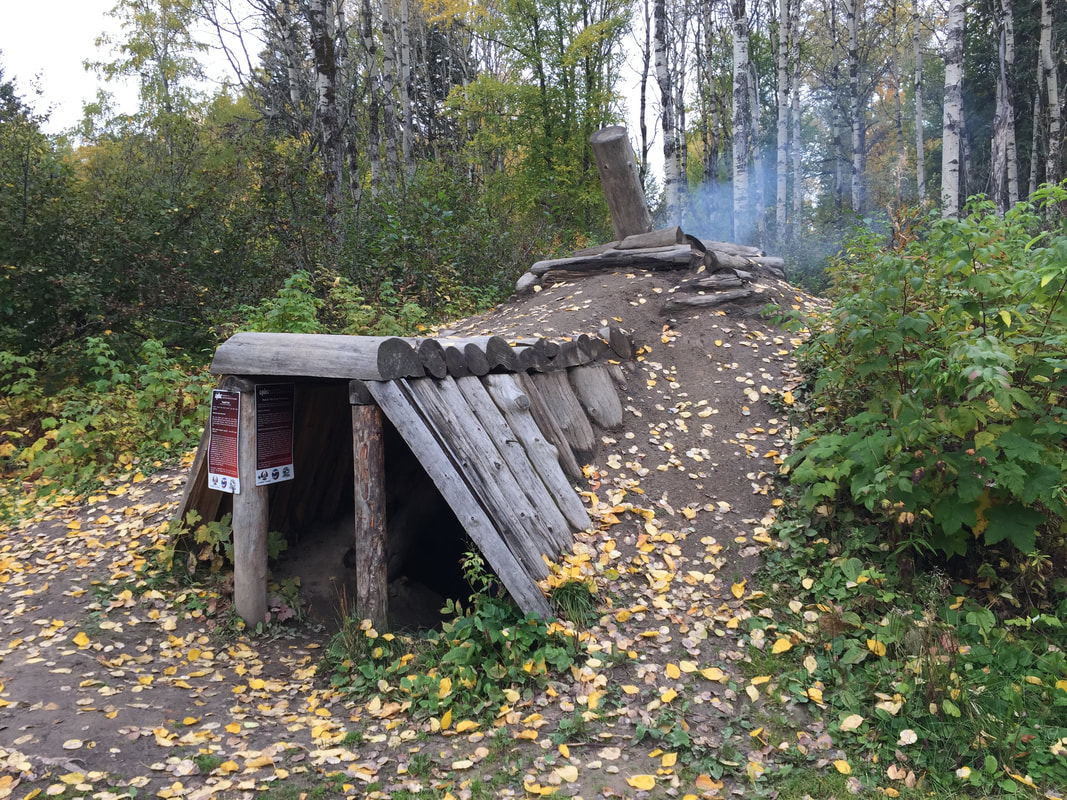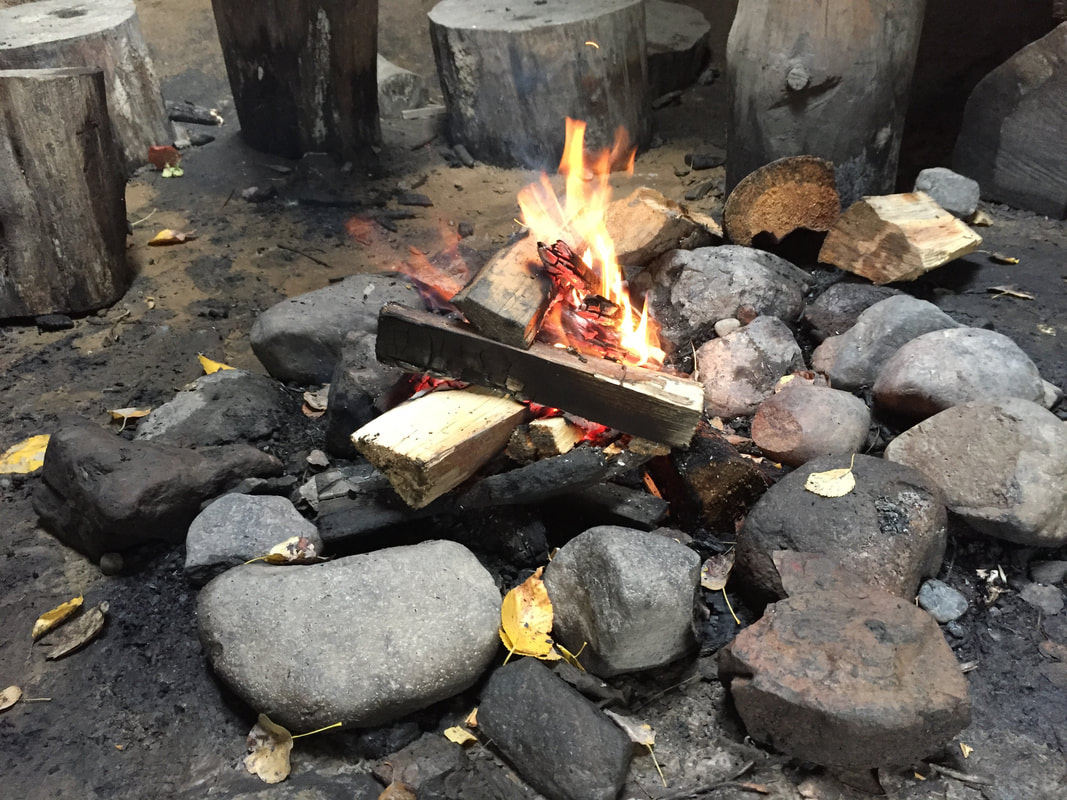Having visited the Pit House near UNBC with my School of Education group a few days prior, I though it would be a good idea to invite the PhD cohort out there as well, in part an orientation to the geography and ecology of the UNBC environs, in part an introduction to the local Indigenous culture -- the Lheidli T'enneh / Dakelh peoples -- and in part as an activity to bring the group together. It's been a busy Fall so far, and one of my few regrets is that I have not made more of an effort to make this group of virtually all international students feel more welcome as special guests in Prince George.
The Pit House came about through a collaboration of local Indigenous leaders and teachers, Indigenous (Lheidli T'enneh) high school students, and an experiential learning class from UNBC. "The pit house the students built is in the Dakelh style. Dakelh translates as the “people who travel by boat” and are the indigenous people from the north-central interior of British Columbia. It’s a traditional winter dwelling historically used by many indigenous peoples around the world" (UNBC). One of folks working on this was Jen Pighin, a colleague and friend of mine. She told me that they named the place "Tsasdil Yoh" which means House of Frogs," because there were so many frogs about when they were building the pit house. Jen encourages visitors to light a little fire, and use this space to reflect and dream, and to learn more about Dakelh culture. So, on Friday, after NRES class, we had a little fire (and lots of smoke) in this unique spot after a leisurely walk on a portion of the Greenway Trail discussing local flora, fauna, and landforms with the help of Roger Wheate. I'm still surprised that I remember most of the Latin names of the local plants after not having used this arcane knowledge for 25 years. For the record I did not name all the plants as we went along, but I did pass on some knowledge I had about Dakelh culture and the Lheidli T'enneh in particular. We didn' stay long, most of the group wanted to carry on and see Shane Lake.
My internal reflection in the pit house, and what I was conscious of even while I was talking, was that my background as a Social Studies teacher and a white settler who has spent almost his entire life in this city and region, has conditioned me to frame discussions and characterizations of local Indigenous culture in the past tense. It has always seemed so much safer to me to compartmentalize traditional culture, ways of knowing, and modes of subsistence in an academic box of the Past, and treat modern Indigenous culture, issues, and realities as something different, something to be problematized or "solved." I think this bias goes deeper in that where there are obvious links between the past and present, I have perhaps tended to see these as symbolic, or manifestations of "creeping determinism" (hinging an argument on hindsight), rather than actual instances of historical continuity. The deep problem here is that Indigenous attempts at reclaiming culture or reviving traditions can be treated as exercises or experiments, and not serious attempts to move into a new cultural norm that is still in sync with the past, with the ancestors. I sense that this bias is not unique to my own trajectory, but is systemic, and is a real barrier to reconciliation. It is not unlike the impact of residential schools that tried to create a sharp break between the past and present. I am resolved to break down this bias and work at seeing the past and present linked through efforts of reconciliation. I am reminded of a graphic I have used with a School of Education class from author Jennifer Katz's book Ensouling Our Schools that compares Maslow's Hierarchy of Needs with a Kainai First Nations concept of actualization through Cultural Perpetuity. In my mind, decolonizing our institutions (and for me, a teaching practice) is to make some serious space for Indigenous people to bridge their own past and present, to weave traditional ways of knowing with modern concerns and daily life in a way that promotes personal wellbeing (in every sense, including economic) and cultural perpetuity.
The Pit House came about through a collaboration of local Indigenous leaders and teachers, Indigenous (Lheidli T'enneh) high school students, and an experiential learning class from UNBC. "The pit house the students built is in the Dakelh style. Dakelh translates as the “people who travel by boat” and are the indigenous people from the north-central interior of British Columbia. It’s a traditional winter dwelling historically used by many indigenous peoples around the world" (UNBC). One of folks working on this was Jen Pighin, a colleague and friend of mine. She told me that they named the place "Tsasdil Yoh" which means House of Frogs," because there were so many frogs about when they were building the pit house. Jen encourages visitors to light a little fire, and use this space to reflect and dream, and to learn more about Dakelh culture. So, on Friday, after NRES class, we had a little fire (and lots of smoke) in this unique spot after a leisurely walk on a portion of the Greenway Trail discussing local flora, fauna, and landforms with the help of Roger Wheate. I'm still surprised that I remember most of the Latin names of the local plants after not having used this arcane knowledge for 25 years. For the record I did not name all the plants as we went along, but I did pass on some knowledge I had about Dakelh culture and the Lheidli T'enneh in particular. We didn' stay long, most of the group wanted to carry on and see Shane Lake.
My internal reflection in the pit house, and what I was conscious of even while I was talking, was that my background as a Social Studies teacher and a white settler who has spent almost his entire life in this city and region, has conditioned me to frame discussions and characterizations of local Indigenous culture in the past tense. It has always seemed so much safer to me to compartmentalize traditional culture, ways of knowing, and modes of subsistence in an academic box of the Past, and treat modern Indigenous culture, issues, and realities as something different, something to be problematized or "solved." I think this bias goes deeper in that where there are obvious links between the past and present, I have perhaps tended to see these as symbolic, or manifestations of "creeping determinism" (hinging an argument on hindsight), rather than actual instances of historical continuity. The deep problem here is that Indigenous attempts at reclaiming culture or reviving traditions can be treated as exercises or experiments, and not serious attempts to move into a new cultural norm that is still in sync with the past, with the ancestors. I sense that this bias is not unique to my own trajectory, but is systemic, and is a real barrier to reconciliation. It is not unlike the impact of residential schools that tried to create a sharp break between the past and present. I am resolved to break down this bias and work at seeing the past and present linked through efforts of reconciliation. I am reminded of a graphic I have used with a School of Education class from author Jennifer Katz's book Ensouling Our Schools that compares Maslow's Hierarchy of Needs with a Kainai First Nations concept of actualization through Cultural Perpetuity. In my mind, decolonizing our institutions (and for me, a teaching practice) is to make some serious space for Indigenous people to bridge their own past and present, to weave traditional ways of knowing with modern concerns and daily life in a way that promotes personal wellbeing (in every sense, including economic) and cultural perpetuity.


 RSS Feed
RSS Feed